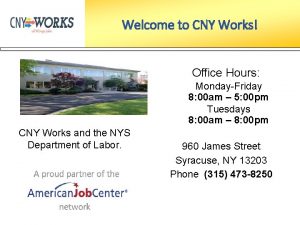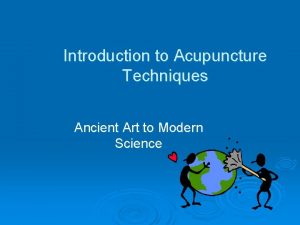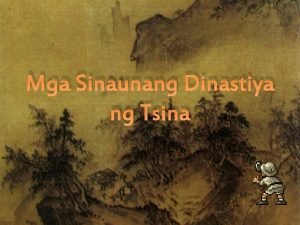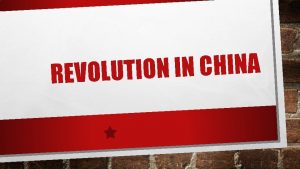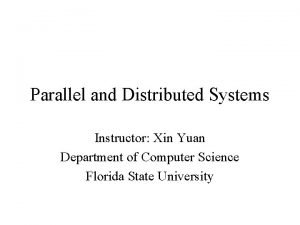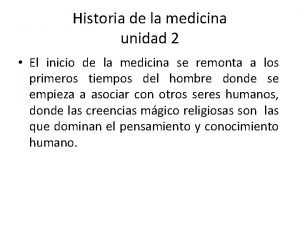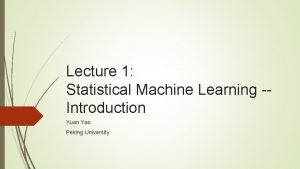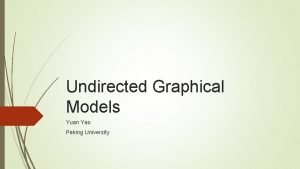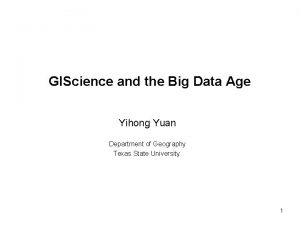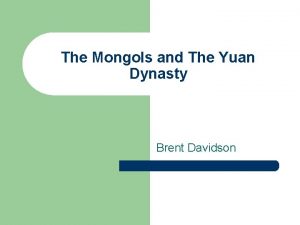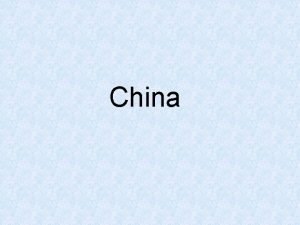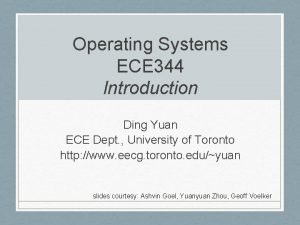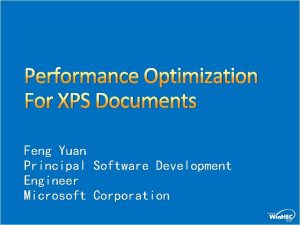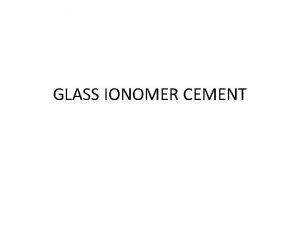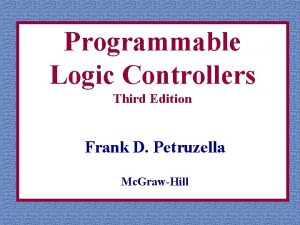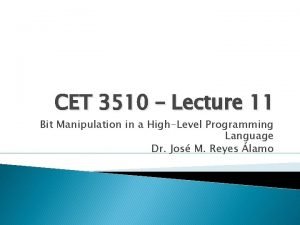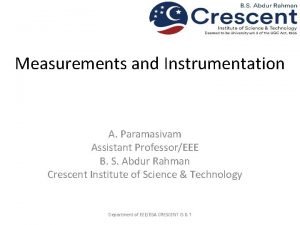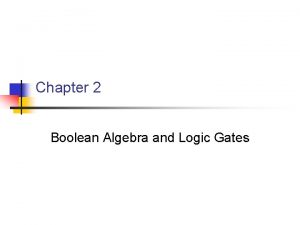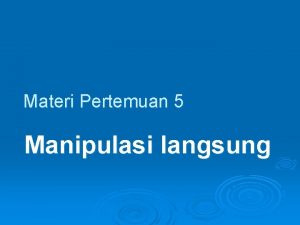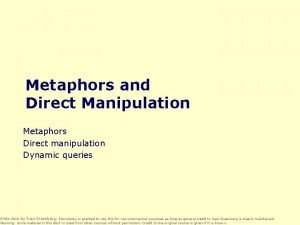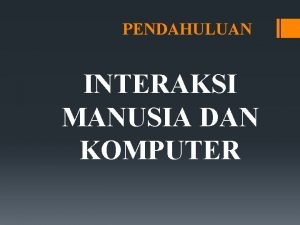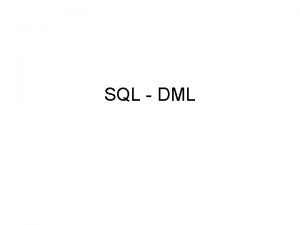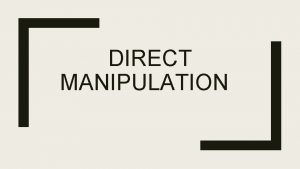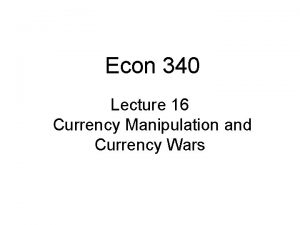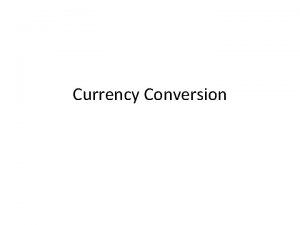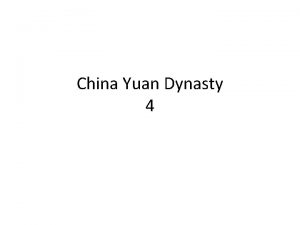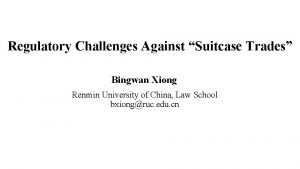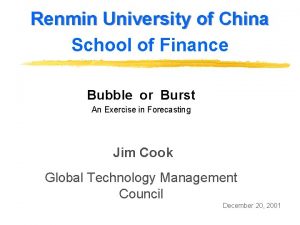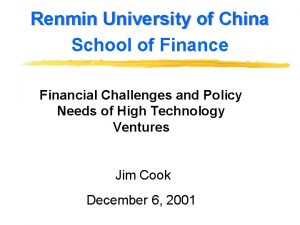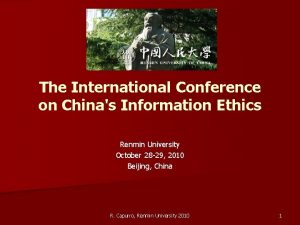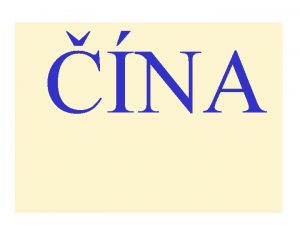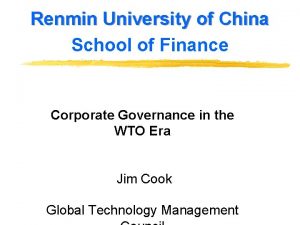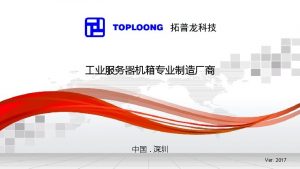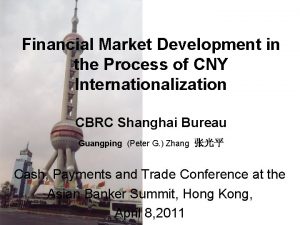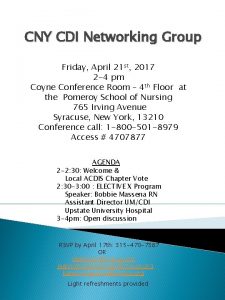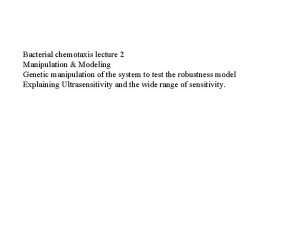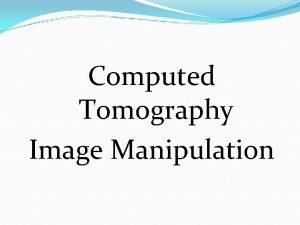Chinese Currency Manipulation Chinese Currency Yuan CNY Renmin





































- Slides: 37

Chinese Currency Manipulation?

Chinese Currency Yuan (CNY) 元 Renmin Bi (RMB) 人民币 Jin 金 Kuan 款 Tael 两 Qian 钱 Yin Bi 银币 Kuai 块 Da Tour 大头 Da Mao 大毛 US$ = Mei Yuan 美元

Agenda n Brief History n How Currency Manipulation works n The Impacts of Manipulation n The Claims against China n Virtual Subsidy n Counter Arguments

International Currency System History n Collapse of Bretton Woods, 1971 -73 n IMF 1977 Decision n Plaza Accords 1985, G 5 devalue USD n 1997, Currency Speculation in Asian Financial Crisis n Euro intro’ 1999, G 7 intervention 2000 n IMF 2007 Decision

IMF 2007 Agreement “A. A member shall avoid manipulating exchange rates or the international monetary system in order to prevent effective balance of payments adjustment or to gain an unfair competitive advantage over other members. ”

China’s Currency System History n Republican China (Pre-PRC), currency problems, rampant hyperinflation n 1949 -78, Closed Economy n 1979 -1994 FEC, dual prices, Foreign Rates n 1994 began peg at 8. 28元: 1 US$ n 2005 ‘floated’ peg

July 21, 2005 “floated” the Yuan n Not really. n Government controlled rate n Max O. 3% daily fluctuation* n = Managed Float / “Dirty Float” n Market determines direction, management retards pace and prevents sudden instability. May 15, 2007 updated to 0. 5%/day.

How Manipulation* works n Prints new Chinese Yuan to make purchases of US$ assets n Chinese Government buys U. S. $ denominated assets n Excess demand for RMB is eliminated n Lowered demand = lowered value n End result: value of RMB suppressed from “naturally” occurring market price. * Distinction between management and manipulation is disputed.


Impact of Currency Manipulation (on U. S. ) Increase U. S. trade deficit n Negatively affect U. S. businesses n – Chinese imports relatively cheaper – U. S. exports to China relatively more expensive Downward pressure on U. S. interest rates (caused by increased investment in U. S. assets) n Capital inflows n Chinese purchased U. S. Treasury bills fund government deficit spending n Compositional shift in U. S. economy n Distortion to “Free Market Conditions”

Impact of Currency Manipulation (on China) n n n ‘Virtual subsidy’ Reduced risk for investors ($ peg) Increased competitiveness for FDI Higher cost foreign consumer imports Higher cost of imported factor inputs (machinery, raw materials, component parts) Lower local wages, Higher employment n Expanded Yuan supply, easy credit, nonperforming loans. n Impedes efficient allocation of resources

Who Benefits? Foreign/US firms exporting from China (400 of Fortune 500) n US consumer (cheaper goods, higher purchasing power) n Component importers from China (resources, machinery, capital inputs, etc. ) n Chinese Economy (manufacturing base, economic growth) n

Who Loses? US firms who compete with Chinese imports (US dom. manufacturing) n US Exporters trying to get into Chinese market n Chinese consumer, individual (wages depressed, low competition) n *** US firms doing business solely in Asia – profits reported in US$; Kodak/Dell case n

Impact “Production Platform China” n China runs trade deficit with all other nations (minus US, China has total deficit of 55 Bil in ‘ 06) n Foreign firms own 50% of export manufacture companies in China n Capital gains from Chinese exports therefore go to foreign (U. S. ) firms n U. S. firms lobby to protect this investment

The Claims on China Intentionally Suppressing RMB value n Fueling economic growth/boom n Suppressing local consumers n Flooding U. S. markets – “dumping” n n Undervalued by 10%-40%

What 40% undervalued means n At current ‘Managed’ Exchange Rate – 1 USD = 7. 54424 RMB – 1 RMB buys 0. 132552 USD n If actual value 40% higher? – RMB would buy 40% more – 1 RMB = 0. 185572 USD – 1 USD = 5. 38874 RMB

Counter arguments Can only impact temporary slowing of market effects (=<30 days) n Guessing actual value “tricky Business” n Manipulation only slows effect, long run the “invisible hand” balances out. n

Movement This Year

Virtual Subsidy – Case Study (US Automakers Claim) 2007 Toyota FJ Cruiser v. 2007 Jeep (Chrysler) Wrangler JKU

Virtual Subsidy – Case Study n April 2007, Automotive Trade Policy Council (Daimler Chrysler, Ford, GM) calls on G 7 Finance Ministers to address imbalance in Yen Exchange Rates n Claim n How does this work? – should be trading at 100¥: 1 USD – U. S. automakers in effect face a $4, 000 subsidy on Japanese made cars

Toyota FJ Cruiser n US market MSRP $22, 545. 00 n Manufactured entirely in Hamura, Tokyo, Japan. n All factors of production in Japan so MSRP is based on production inputs in ¥ n So that MSRP is actually ¥ 2, 682, 855 divided by April 2007 exchange rate of ¥ 119: 1 US$ to get the MSRP of $22, 545 in the U. S. market.

Jeep Wrangler JKU n US market MSRP $21, 190. 00 n Manufactured entirely in Toledo Ohio, USA. n All factors of production in USA so MSRP is based on production inputs in US$ n So that MSRP is actually $21, 190. 00 MSRP for the US market is completely unaffected by foreign exchange rates with any currency.

Virtual Subsidy? MSRP ¥ 2, 682, 855 $26, 828. 55 in US$ At ¥ 100: 1 US$ MSRP $21, 190. 00

Virtual Subsidy? MSRP ¥ 2, 682, 855 $26, 828. 55 in US$ At ¥ 100: 1 US$ MSRP $21, 190. 00 At ¥ 119: 1 US$ MSRP ¥ 2, 682, 855 $22, 545. 00 in US$ $4, 283. 55 in US$ MSRP $21, 190. 00

Virtual Subsidy – Case Study 2 (Anti-China Lobby Claim) Chinese Manufacturing Advantage

Thomas the Tank Engine (Lead-based paint optional) n MSRP $9. 89 ea. n Manufactured entirely in China, therefore MSRP based on factors of input in RMB n Current n So Exchange rate 1 US$: 7. 54 RMB actual MSRP = 74. 61 RMB expressed in US$ is $9. 89 ea.

Thomas the Tank Engine n If overvalued at 40% (“The Big if”) n Exchange n The rate would be: 1 US$: 5. 39 RMB same MSRP = 74. 61 RMB expressed in US$ would be: $13. 84 ea.

So What? n Your cost goes up from $9. 89 to $13. 84 ea. n You pay 39% increase? OR, according to US manufacturing lobby n. A US firm can make Thomas locally for less than $13. 84 ea. n Thus manufacturing and the related jobs return to the U. S.

Loss of Manufacturing to China? n Are we losing manufacturing jobs to China? n Has currency manipulation caused, or exacerbated that loss?

A drop in US Manufacturing Employment?


Long Term Trends in Manufacturing

Due to Competition, or Productivity?

Chinese Argument n n n Our developing economy is unstable Currency management necessary to prevent crisis that would impact world economy Must wait until further market reforms (SOE conversions, etc. ) are complete Chinese banking system underdeveloped Vulnerable to currency speculation (Thai Baht 1997) Political risk: currency up? > income down > employment down > worker unrest > domestic political challenge/crisis = Internal Affairs

Chinese Argument n n Whaaaaa, Boo-hoo We’re a Third World Nation Stop Beating us up American Bully!

U. S. Policy Implications n Legislative Action – Require reporting – Require negotiations – Institute tariffs to counter ‘virtual subsidies’ § H. R. 1002 (Spratt), S. 1586: 27. 5% tariff on Chinese goods – Prohibit US Do. D purchases from China – Ban federal procurement from the country n n n Report to IMF Clarify definitions, remove intent, Manipulation vs. misaligned

Questions?
 Cny works phone number
Cny works phone number Mena rmb
Mena rmb Primary 2 malay worksheets
Primary 2 malay worksheets Taoism origins
Taoism origins Kurs yuan bca
Kurs yuan bca Ancient arts acupuncture
Ancient arts acupuncture Dinastiyang tang: wood block printing: dinastiyang sui:
Dinastiyang tang: wood block printing: dinastiyang sui: Xin zan
Xin zan General yuan shigai
General yuan shigai Yuan-pern lee
Yuan-pern lee Xin yuan fsu
Xin yuan fsu Codigo hsi yuan lu
Codigo hsi yuan lu Yuan yao math
Yuan yao math Yuan logo
Yuan logo Liao yuan
Liao yuan Model yuan yao
Model yuan yao Yihong yuan
Yihong yuan Yuan dynasty map
Yuan dynasty map Manchurian border
Manchurian border Ding yuan toronto
Ding yuan toronto Feng yuan microsoft
Feng yuan microsoft Shupei yuan
Shupei yuan Lan security concepts
Lan security concepts Hiatal hernia visceral manipulation
Hiatal hernia visceral manipulation Data manipulation vulnerability
Data manipulation vulnerability Sprue former
Sprue former Classification of gic
Classification of gic Data manipulation instructions enable the plc to
Data manipulation instructions enable the plc to Bit manipulation examples
Bit manipulation examples Variable manipulation element
Variable manipulation element Algebric manipulation
Algebric manipulation Manipulation quotes
Manipulation quotes Metaphor for manipulation
Metaphor for manipulation Latar belakang imk
Latar belakang imk Sql queries
Sql queries Ateliers individuels de manipulation
Ateliers individuels de manipulation What is direct manipulation
What is direct manipulation Trituration definition in dentistry
Trituration definition in dentistry
